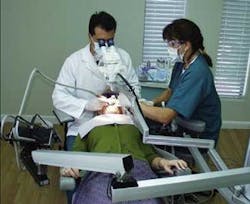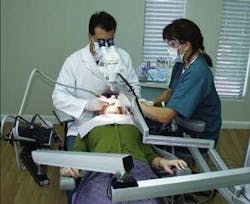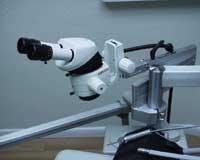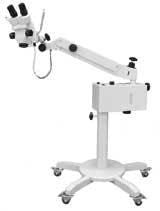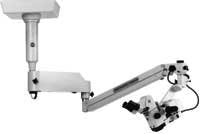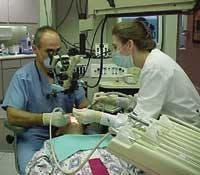Maintaining Visual and Physical Peace of Mind
by Gerard M. Cuomo, DDS
The dental operating microscope is considered one of the most effective pieces of dental equipment used today, yet only a small number of dentists actually buy a system.
Common reasons dentists give for not purchasing a microscope system include —
• The system will take up too much valuable operatory space.
• There is a steep learning curve for microscopy. (Since most dentists use loupes, there is often apprehension of new technology and a feeling that old habits are too difficult to change.)
• Dental microscope systems are expensive.
• Maintenance of the system is intricate and time consuming.
Hours could be spent discussing these reasons, however, instead of focusing on reasons for not purchasing a microscope system, it is imperative to examine the reasons for purchasing one. Besides the obvious benefit of advanced magnification, another benefit to emphasize is the proper head and neck positioning afforded the dentist who uses a dental microscope system vs. one who uses loupes — posture-directed dentistry vs. image-directed dentistry.
Over time, the ergonomics of practicing dentistry has evolved. Decades ago, dentists stood all day as they extracted teeth, filled cavities, etc. Eventually, dentists realized that sit-down dentistry eased muscle tension and soon it became mainstream. This change in positioning improved the comfort level of dentists, but it did not eliminate neck, shoulder, and back pain.
In addition to sit-down dentistry, the use of loupes has also become commonplace in the dental operatory. The development and use of Galilean and Prismatic dental loupes have advanced the dentist's ability to work at a higher level of detail. Furthermore, the headlight, in conjunction with the use of loupes, has added the illumination necessary for higher magnification. However, besides adding magnification and light, these two devices have also added weight to the dentist's head.
The human head, depending on the individual, weighs between 15 and 20 pounds. Figure 1 illustrates the head as a bowling ball, resting on the neck and back muscles represented as a polygon platform. The arrows illustrate various head movements and positions made throughout the day. This analogy speaks for itself — keep the head balanced with less movement and the neck and back support will stay healthy. Conversely, excessive head movement will cause imbalance and increased stress on the neck and back muscles, resulting in pain and discomfort.
Neck, back, and sacral muscles act in concert during procedures, yet their interactions often go unnoticed until pain occurs from over-use. As practicing dentists, we have developed unconscious habits in the way we position ourselves and react to given situations while in the sit-down mode. Our line of sight follows the image we want to view, and our neck, shoulder, and back muscles get us there. It is important for us to be aware how often and for how long we contort our heads and necks into uncomfortable positions while viewing different areas of the mouth during dental procedures. The key to changing these old habits is to understand the difference between posture-directed and image-directed dentistry.
Posture-directed vs. image-directed dentistry
Figure 2 shows a loupe-and-headlight setup with the line-of-sight arrows directed toward an object.
Figure 3 illustrates the same concept using a camera and tripod — the lens of the camera represents the dental loupes, the camera body represents the head, and the tripod represents the neck and back. In order for an object to be seen, the camera body must be pointed in the direction of the image (line of sight) making it an "image-directed" piece of equipment. Dental loupes, like the camera, are image-directed equipment. Those who wear dental loupes often realize that even when images are magnified, there are limitations in preventing neck and back muscle soreness.
Conversely, the use of a dental microscope system (see Figure 4), allows the dentist to become "posture-directed" by changing the line of sight. Instead of your neck — the tripod in Figure 3 — controlling the range of motion to the line of sight, it is the microscope's range of motion that establishes the line of sight. Dental microscope systems are the camera lens, body, and tripod all in one. The dentist's body posture remains in a constant relaxed position throughout an entire procedure. The simple movements of the patient's head, dental chair, and microscope all help maintain healthy posture.
In his lessons, F.M. Alexander, the world-renowned mind/body expert, demonstrated the idea of "stop and think before you act." The Alexander Technique is a method that helps one discover a new balance in the body by releasing unnecessary tension. It is a simple and practical method for ease and freedom of movement as well as for balance, support, and coordination.
In many ways, the use of a dental microscope also involves re-educating the mind and body. Changing the line of sight allows dentists to change old habits, improve body posture and, ultimately, provide the needed energy for performing long procedures. There is no doubt that with practice, old habits can be broken.
Two resounding questions still remain —
1) Is the relationship between the head and the rest of the body of utmost importance?
2) Will managing that relationship over time have any long-term benefits?
The answer to the first question affects the answer to the second. The dentist who recognizes the importance of the relationship between the head and body and takes the necessary steps to preserve physical well-being will benefit in the long term. There are several dental microscope companies, both large and small, that provide equipment for the dentist who wishes to achieve the goal of posture-directed dentistry. In addition, this equipment provides precise and productive magnification. Advanced magnification is the way of the future and most assuredly is the way to maintain your visual and physical peace of mind.
A variety of brands, styles, and prices are available according to your needs and budget — from basic to high-end — with multiple mounting options including portable units.
Opti-Link® dental microscope system
Expanding Images offers the compact, space-saving Opti-Link microscope system that attaches directly to the dental chair. Designed by a dentist for the legendary Leica MS5 binocular microscope, it offers one of the finest color and image resolution lenses along with six steps of magnification. It's portable and can be moved from operatory to operatory or transported from office to office. This lightweight microscope system installs in minutes and is guaranteed for life. Available options include an ICA video camera and ErgoWedge adjustable binocular tubes.
Seiler
In addition to the floor models shown, the Revelation also is available in wall-mount and ceiling-mount models. Starting price for the Revelation is $8,495. Also available is the Seiler 202/402 Dental Operating Microscope. This microscope starts at $4,195 and is available in floor model, wall-mount, and ceiling-mount.
For more information, call (800) 489-2282 or visit www.seilerinst.com.
Carl Zeiss OPMI® pico dental microscope
Carl Zeiss brings you outstanding microscopic diagnostics and microsurgical therapy with the OPMI pico dental microscope with integrated video. Orange and green filters enhance your work with composite materials or in procedures with heavy blood flow. Five steps of magnification provide definition where loupes no longer suffice. Ease of movement, comfortable sitting posture, controls at your fingertips, and aseptic solutions with a system that easily integrates into your office setting make the OPMI pico the ultimate visualization solution at an affordable price. The OPMI pico S100 system is available in floor, wall, or ceiling-mount models.
For more information, call (800) 442-4020.
Harris high-quality stereo microscopes
Harris Discount Supply offers a full-featured Surgical Microscope. This unit has everything — 3X to 13X zoom magnification, a 74 mm to 16 mm viewing field, fiberoptic lighting, and either mobile stand or wall-mount options. It comes complete with a five-year warranty, all for $2,495.
For more information, call (800) 227-8524.
JedMed V-Series endodontic
microscope
JedMed offers precision instruments at affordable prices. Features include high-quality German optics with five-step or manual zoom magnification; inclined binoculars with adjustable eyepieces; improved balance features; and choice of integral or fiberoptic illumination. JedMed offers other microscope styles and mounting options. An integrated video system also is available.
For more information, call (314) 845-3770 or visit www.jedmed.com.
Global Dental Microscopes equip HSP's endodontic operatory
Microscope use demands a thoughtful equipment design. Dentists find that the HSP endo operatory equipped with the leading Global dental microscope is a "marriage made in dental heaven," offering proper positioning and support for comfortable chairside technique.
For more information on the HSP endo operatory, call (800) 237-5794 or visit www.hspinc.com. For more information on Global's complete line of dental microscopes, call (800) 861-3585 or visit www.globalsurgical.com.
